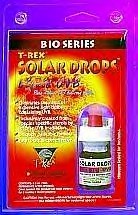Other Frog Health Maladies
Paralyzed Legs
 There are several suspects when it comes to paralyzed legs in frogs. Frogs
that are wild-caught, or raised from tadpoles that were taken from wild sources,
could have been subjected to Weed killers (such as Round-Up) and fertilizers that
contaminated their water sources. This has lead to many mutations and deformities
in frogs, but has also been attributed to paralyzation in frog's legs.
There are several suspects when it comes to paralyzed legs in frogs. Frogs
that are wild-caught, or raised from tadpoles that were taken from wild sources,
could have been subjected to Weed killers (such as Round-Up) and fertilizers that
contaminated their water sources. This has lead to many mutations and deformities
in frogs, but has also been attributed to paralyzation in frog's legs.
Other suspects are heavy-metal poisoning, another pollution added to the environment by Man. Exposure to nitrates and nitrites can also cause paralysis. Also, various parasitic trematodes have caused paralysis and death in Xenopus Laevis.
Lastly, if you've fed your frog beef liver tidbits , he may be suffering from a lack of vitamin A and D, which can also bring on some of the symptoms listed here.
SymptomsFrogs either lose the use of their hind legs slowly, or become paralyzed altogether. Irregular muscular activity and failure of muscular coordination (ataxia), partial paralysis of the hind legs, dilated pupils unresponsive to light, and a loss of the righting response. The skin is often dry on the head and back.
In tadpoles and young frogs, a reduction in their feeding activity, swimming becomes less vigorous, some may experience disequilibrium, may even develop some physical abnormalities, suffer paralysis.
Before treating this, read about Cramping and Paralyzed Legs. Also read Chytridiomycosis symptoms.
TreatmentGet a Vitamin B complex tablet and Potassium tablet intended for Humans. Crush one of each to a fine powder with a mortar and pestle. Place 1/2 teaspoon of the Vitamin B complex powder and just a dash of the crushed potassium tablet and place in cricket duster. Feed the frog crickets dusted in this powder daily for 1 week, then every other day the following week. After this, switch to a Vitamin compound specifically designed for Herps, and dust your frogs' insects with it every two weeks.
If your frog is aquatic, bathe him in 1 teaspoon of the vitamin B and potassium (crushed) in 2 quarts of water. Place him in this bath for 1 hour, twice a day. Then rinse the frog in proper temperature treated water and return to hospital tank.
If you suspect trematodes, add this treatment to the vitamin regimen listed above. Crush 1/4 tablet of Parasite Clear tablet (made by Jungle and in petshops) and mix in 6 ozs. distilled water. Using an eyedropper, place 1 drop onto frogs' dorsum every other day for 6 days. After 30 days, repeat this treatment.
Sadly, all frogs may not recover. Never place the survivors back with your main collection, this can be transferred later to healthy frogs. Give them their own tank.
Remove permanently all snails, land or otherwise. Also all fish, permanently. Switch to good bottled spring water or use 'Amquel' combined with NovAqua as a water conditioner and heavy metal remover. Scientists have already found metals heavy enough in tap-water to cause paralysis in frogs. (And this water is below the EPA standards too, still affects frogs) Only combining the use of NovAqua and Amquel will remove these metals if you're starting off with tapwater.
Note: Nitrite may also be present in tap water at a high enough rate to affect frogs. Learn more about nitrites on the Water101 page.
Cramping or lightly paralyzed legs
 This problem can usually be prevented by insuring that the frogs receive enough
calcium with with just a dash of crushed potassium tablet added to their diets.
Frog kicks, jerks, and becomes lightly
paralyzed. Can be life-threatening. See also
Chytridiomycosis symptoms before using this treatment, to be sure
this one is the right one, as well as Paralyzed Legs and read those symptoms.
This problem can usually be prevented by insuring that the frogs receive enough
calcium with with just a dash of crushed potassium tablet added to their diets.
Frog kicks, jerks, and becomes lightly
paralyzed. Can be life-threatening. See also
Chytridiomycosis symptoms before using this treatment, to be sure
this one is the right one, as well as Paralyzed Legs and read those symptoms.
The vitamin supplement powders do contain calcium (The powders you should be dusting your frogs food insects with) and if you use as directed, the frog's health should improve. As stated above, buy some Potassium tablets and add just a dash to the dusting powder. However, if the legs are becoming paralyzed, you may need to mix Calcium complexes such as Calcium-Sandoz at 10% and Calcium borogluconate in 2 oz. distilled water. Then place 0.1 ml in plastic eyedropper, place on dorsum. Treat him for two days, once daily.
Another treatment for cramping only is a vitamin A and D3. (vitamins that you have crushed with a mortar and pestle) Use 2 grams to 10 ml of water, place one drop daily on dorsum with eyedropper for 6 to 7 days.
Jumping Disease
This disease could be contagious, so you will need to clean and sterilize not only the main tank, but the hospital tank afterwards as well. There is only 1 known treatment for this, called "Panotile". It is a German medication, and may be hard to find here in the states (Ask your veterinarian about getting a couple of tablets). It is also called Inpharzam.
TreatmentFirst dilute medicine slightly with distilled water. Place 1 drop panotile on dorsum. Skip one day, and then repeat. Treat a total of 10 days, 5 days with medication. It is not yet known if this treatment will kill the pathogen, your frogs may stay transmitters, so returning them to a main tank with frogs that you know are not infected may not be a good idea. See if you can set them up a separate tank. Do Not release these frogs into the wild, ever. They can infect the natural population!
Scratching Disease
SymptomsYour Frogs will begin scratching themselves, especially on the flanks and dorsum. This behavior will be more intensified right after you have misted the vivarium. As time goes on, the affected frog(s) will become more lethargic, eventually stopping all activity and then refusing food. If nothing is done, the frog will end up dying, and he usually seeks out a pool or waterdish to expire in. If an aquatic frog that lives with snails, remove them now, place in their own tank from now on. That means forever.
What to do NowYou'll need one Inpharzam tablet or capsule. Grind well into a powder with a clean mortar and pestle. Add 2 ounces of distilled water to the crushed tablet. Swirl and try to dissolve all into water before transferring to a clean eyedropper. (Label it as "Inpharzam", so you can use rest later for other treatments if needed.)
Quarantine the frog. Add one drop every other day for 6 days (a total of 3 treatments). to his dorsum via eyedropper. If he's an aquatic frog, place him in a 1 quart bath in which you've added 3 drops of the medication. Dump the old bath when ready to give new treatment. After the bath, rinse the aquatic in proper temp. clean treated water before return to hospital tank.
The saddest part of this disease, is the fact that even though this may "cure" the frog(s) he may still be a "carrier" of it. Therefore, He (they) should now be kept in a new vivarium/tank all to themselves.
Spindle Leg
 Spindly Leg Syndrome affects tadpoles. It can be caused by a multitude of problems.
The water in which you keep your tadpoles could be either too hot or too cold. A lack of
iodine in their water could also be the culprit. Also, a lack of the proper trace elements
or even in-breeding could have caused this malady. Lastly,
(and this should not be a factor if you have thoroughly
read through
the Tadpole Care page) a contaminated
tadpole nursery tank or poor water quality should be considered.
Spindly Leg Syndrome affects tadpoles. It can be caused by a multitude of problems.
The water in which you keep your tadpoles could be either too hot or too cold. A lack of
iodine in their water could also be the culprit. Also, a lack of the proper trace elements
or even in-breeding could have caused this malady. Lastly,
(and this should not be a factor if you have thoroughly
read through
the Tadpole Care page) a contaminated
tadpole nursery tank or poor water quality should be considered.
Spindley, thin, and brittle appearing legs on your tadpoles and froglets. Front legs are especially affected. Froglet may or may not have hard time moving his back legs.
What to do NowThe cure is relatively simple and may correct itself. Well-filtered water, even temperatures always, practicing good genetically diverse breedings, and adding a liquid trace element to their tanks can stop this. Make sure the tadpoles are receiving a herp vitamin complex that includes vitamin A and D3. Be cautious in the amounts of both the trace elements and herp vitamin aides you add. Tadpoles need only a pinch (or a drop) in the tanks I describe on the Tadpole Care page. (Tadpoles can be over-medicated easily. It will only take a very small amount to prevent spindly leg from occurring.
You can also help prevent this from even happening by making sure the parents have been eating insects dusted with vitamins. To a newly bought bottle of cricket dust, add one crushed, powdered tablet of folic acid! Mix well. Make sure adults also have been exposed to small amounts of liquid trace elements.
However, if you don't catch this soon enough, it is most likely that the animal will die. It is hard for them to eat with this condition, so morphs usually die from lack of nutrition.


